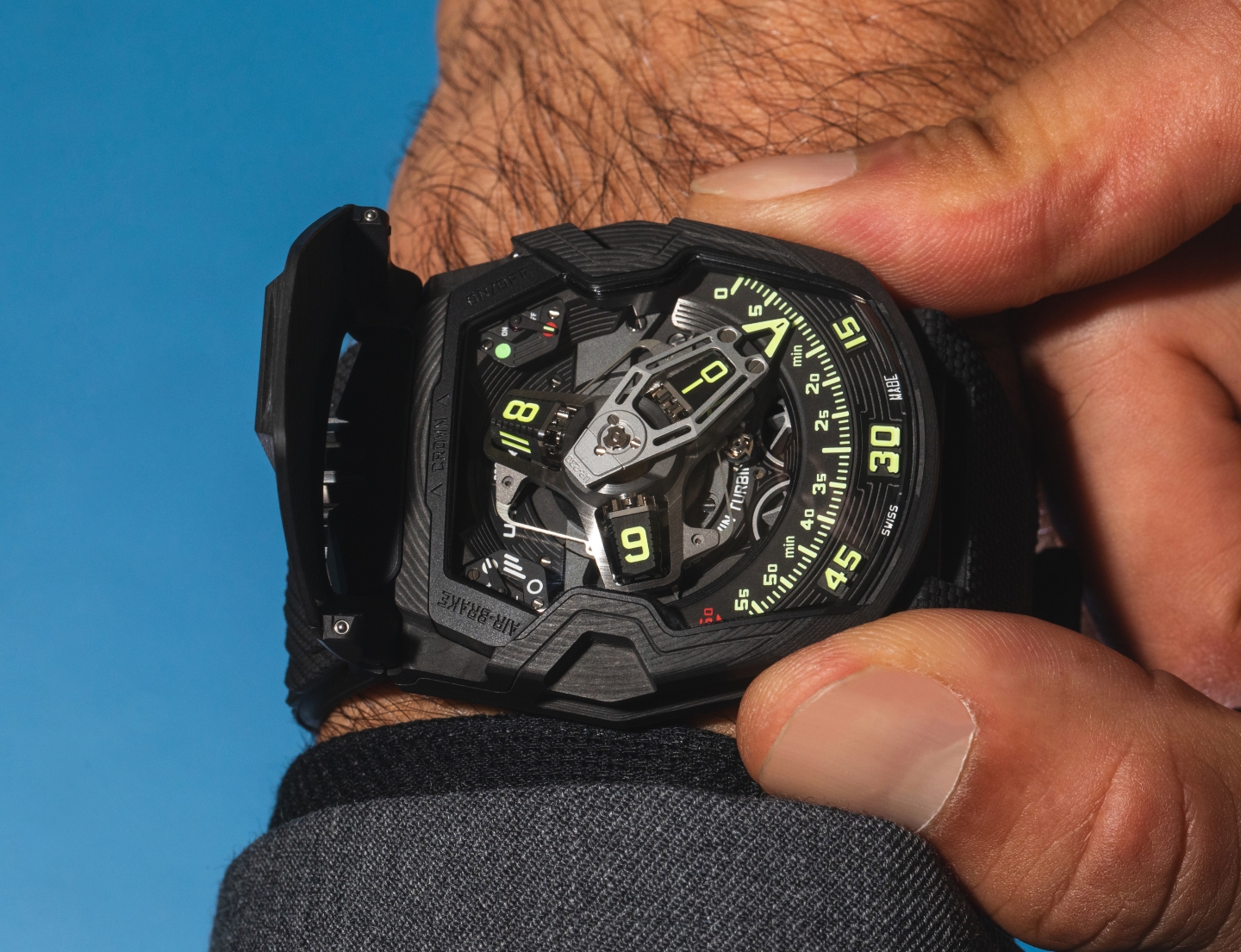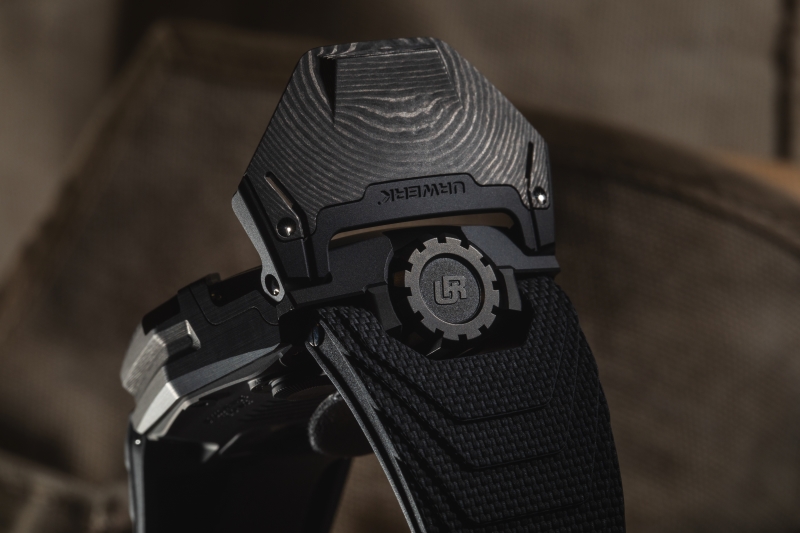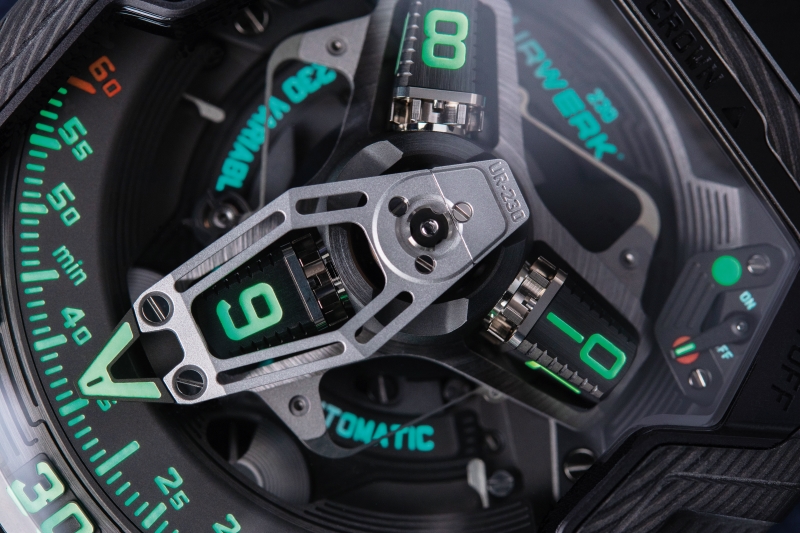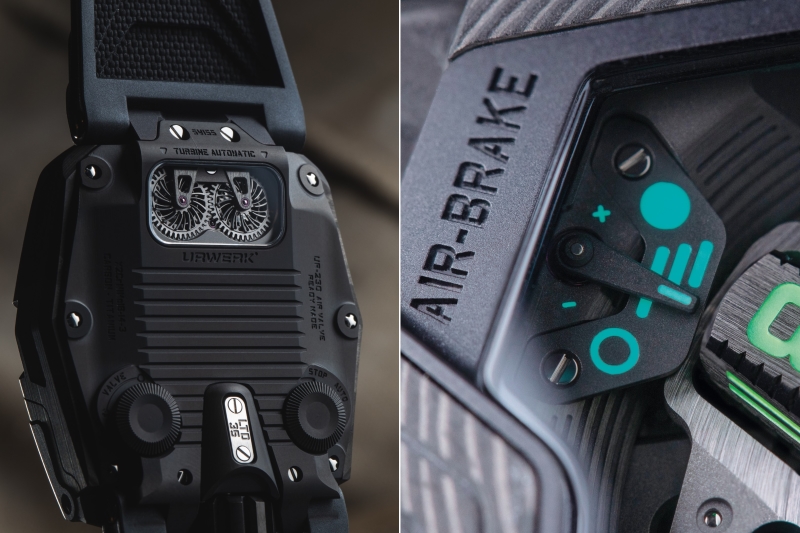
The UR-230 Eagle is a clear enhancement of its predecessors, but takes pride of place as the sharpest and most robust of the flock (All photos: Urwerk)
The evolution of Urwerk’s UR-200 line has been interesting to witness. The latest from the independent Geneva-based brand is the UR-230 Eagle, whose distinctive case shape debuted in the 2007 UR-201 Hammerhead, and was then refined in the steel UR-210 Maltese Falcon in 2012.
Urwerk has a fair number of futuristic and hypermodern designs in its portfolio, but the UR-200 family’s success is in amalgamating all that sci-fi inspiration and impressive technicality into a sublime and wearable package. The UR-220 Falcon Project followed in 2020, this time with a slimmer profile in carbon composite framing its wandering hours and satellite complication.
Urwerk has always been big on engagement and often includes ways in which the wearer can interact with his timepiece. The UR-210 Maltese Falcon features a selector wheel that manually allows the rotor to fully spin, with some resistance, or be locked. The UR-220 Falcon presents the Hammerhead’s “oil change” indicator in a new guise, keeping a running track of how long (in months) the movement has been in operation and serves as a reminder of the upcoming recommended service interval (every 39 months). The UR-230 Eagle is a clear enhancement of its predecessors, but with a few new tricks up its sleeve, it takes pride of place as the sharpest and most robust of the flock.
urwerk_ur-230_lifestyle_5.jpg

The UR-230 lives up to its bird of prey moniker in many ways. At first glance, the most apparent addition is the mobile cover fitted over the dial. It not only endows the watch with a whole new profile, but also serves as added protection for the sapphire crystal glass. The beak-shaped edge provides a finger grip that enables it to be lifted 90° to reveal the satellite system underneath and when closing, a braking device ensures it rests back gently on the sapphire crystal before clipping into place. Integrated into the case, the cover also fuses CTP (Carbon Thin Ply) carbon and titanium. This time, the carbon case is developed with even more layers.
“It’s three times as fine compared to the last piece,” says Urwerk co-founder Martin Frei.
The carbon is machined in superimposed layers and pressure-bonded at high temperatures. A portion is then carved out from the block, revealing a geometric pattern that resembles wood. “When the cover is closed, you see that almost-wooden structure. It’s a bit asymmetric, like a tree growing with irregular rings.”
The material is a favourite among watchmakers for a reason. Besides providing this particular dark, organic graphic aesthetic, carbon is lightweight and highly durable.
“The Eagle is a heavier piece, but it is still light. Even though the bird is strong and big, it is also very light and agile. So we used this analogy,” explains Frei. “We also named it after the hunting bird because of the beak on the hand.”
urwerk_ur-230_macro_4.jpg

Time is read via the rotating hour cubes on the satellite and retrograde minute hand. The aquiline pointer drags across the minute track and snaps back to 0 after 60 minutes to accommodate the following hour block.
“Also, the hands here are skeletonised, so that makes it lighter, even though it appears bigger,” he adds.
The watch is paired with a rubber strap.
“We don’t use alligator straps anymore. We used to like it a lot because it was a contrast to the techno world. But we understand that people are not that much into it anymore. If you’re in a humid country, it’s not so good either. We are really happy with this piece.”
Another primary feature of this automatic watch is the new “air brake” system that utilises turbines as shock absorbers.
“So, Felix [Baumgartner, the other co-founder of Urwerk] told me this from the technical side. He had worked for a while to create — I think for Audemars Piguet or Vacheron Constantin back in the day — very flat watches with the rotor but always had to fix the rotor because it was overriding. So, to protect that, we created this kind of ‘air brake’ to soften certain strong hits, like when you clap or play sports.”
The turbines in the movement essentially control the amount of air that enters the chamber housing the rotor. The first set of turbines is dedicated to attenuating the impact of external shock, acting like an air cushion to protect its UR-7.30 calibre. The second set controls the flow of air that feeds the winding system. When air is restricted, the automatic rotor moves more slowly, so the risk of overwinding is reduced. This can be adjusted via a rotating knob on the back of the watch. Alternatively, there is the option to disengage the rotor completely, turning the watch into manual winding mode. These two functions are indicated at 11 o’clock and 1 o’clock on the dial.
urwerk_eagle.jpg

Practical or not, the functions definitely encourage wearer engagement. It is the sense of wonder and human touch that Urwerk wants to bring back to timekeeping.
Frei says, “Time is a fascinating thing. If you’re creating watches, you need to be fascinated by time. We create machines like the old watchmakers, but the values we hold high aren’t so much the traditional shapes and things, but the ideas, like that of Galileo.
“We don’t need mechanical watches. You don’t need them anymore to tell time. We have all the devices to organise our day. So they become freer.”
As such, each new project is a blank canvas for the mad scientists at Urwerk.
When asked what sort of materials he would like to experiment with, Frei replies: “Tantalum, but the problem is really there is not enough material. The other things I wanted to try out are cobalt and tungsten. But tungsten has limits as you can only make simple shapes with it because it has to be powder, and the powder is hammered into a shape. So, it can’t really be drilled or have something carved out of it. That’s a problem.”
The UR-230 Eagle is produced in a limited series of 35.
“At Urwerk, everything is limited. We always made around 150 pieces a year. But now, it’s going towards 200,” says Frei.
He hints that the brand will be working on another version later on, but only time will tell how it will take shape.
This article first appeared on Jan 22, 2024 in The Edge Malaysia.


